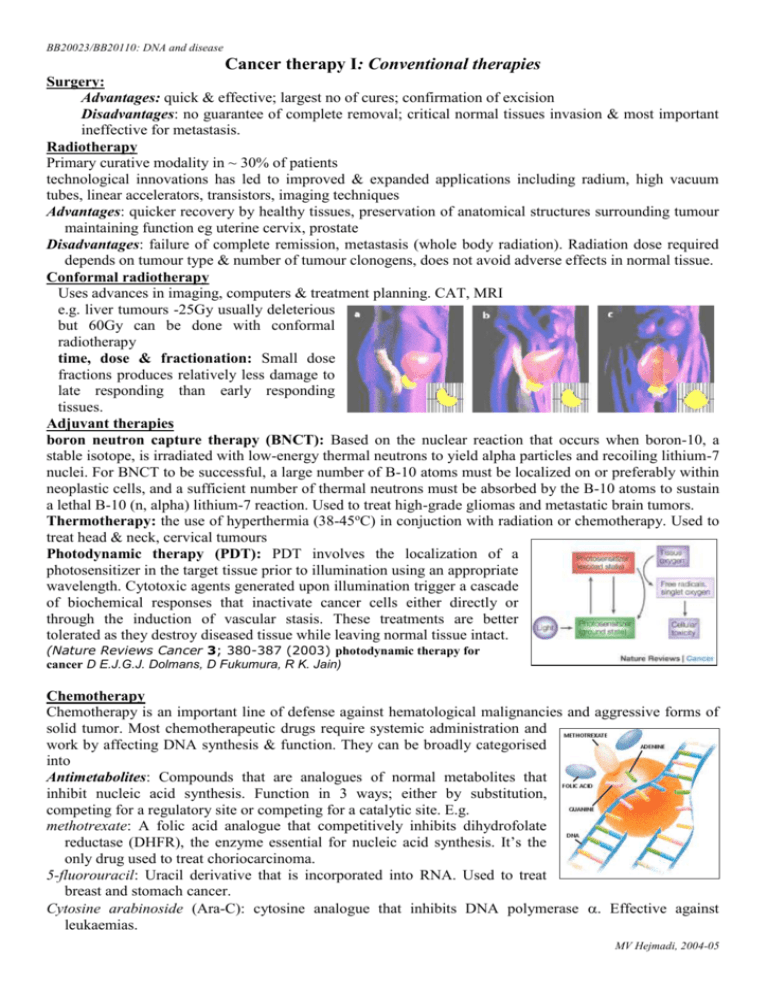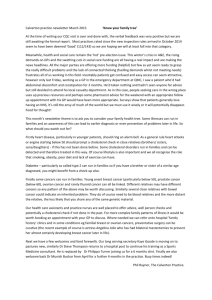Cancer therapy I ( lecture 17)
advertisement

BB20023/BB20110: DNA and disease Cancer therapy I: Conventional therapies Surgery: Advantages: quick & effective; largest no of cures; confirmation of excision Disadvantages: no guarantee of complete removal; critical normal tissues invasion & most important ineffective for metastasis. Radiotherapy Primary curative modality in ~ 30% of patients technological innovations has led to improved & expanded applications including radium, high vacuum tubes, linear accelerators, transistors, imaging techniques Advantages: quicker recovery by healthy tissues, preservation of anatomical structures surrounding tumour maintaining function eg uterine cervix, prostate Disadvantages: failure of complete remission, metastasis (whole body radiation). Radiation dose required depends on tumour type & number of tumour clonogens, does not avoid adverse effects in normal tissue. Conformal radiotherapy Uses advances in imaging, computers & treatment planning. CAT, MRI e.g. liver tumours -25Gy usually deleterious but 60Gy can be done with conformal radiotherapy time, dose & fractionation: Small dose fractions produces relatively less damage to late responding than early responding tissues. Adjuvant therapies boron neutron capture therapy (BNCT): Based on the nuclear reaction that occurs when boron-10, a stable isotope, is irradiated with low-energy thermal neutrons to yield alpha particles and recoiling lithium-7 nuclei. For BNCT to be successful, a large number of B-10 atoms must be localized on or preferably within neoplastic cells, and a sufficient number of thermal neutrons must be absorbed by the B-10 atoms to sustain a lethal B-10 (n, alpha) lithium-7 reaction. Used to treat high-grade gliomas and metastatic brain tumors. Thermotherapy: the use of hyperthermia (38-45oC) in conjuction with radiation or chemotherapy. Used to treat head & neck, cervical tumours Photodynamic therapy (PDT): PDT involves the localization of a photosensitizer in the target tissue prior to illumination using an appropriate wavelength. Cytotoxic agents generated upon illumination trigger a cascade of biochemical responses that inactivate cancer cells either directly or through the induction of vascular stasis. These treatments are better tolerated as they destroy diseased tissue while leaving normal tissue intact. (Nature Reviews Cancer 3; 380-387 (2003) photodynamic therapy for cancer D E.J.G.J. Dolmans, D Fukumura, R K. Jain) Chemotherapy Chemotherapy is an important line of defense against hematological malignancies and aggressive forms of solid tumor. Most chemotherapeutic drugs require systemic administration and work by affecting DNA synthesis & function. They can be broadly categorised into Antimetabolites: Compounds that are analogues of normal metabolites that inhibit nucleic acid synthesis. Function in 3 ways; either by substitution, competing for a regulatory site or competing for a catalytic site. E.g. methotrexate: A folic acid analogue that competitively inhibits dihydrofolate reductase (DHFR), the enzyme essential for nucleic acid synthesis. It’s the only drug used to treat choriocarcinoma. 5-fluorouracil: Uracil derivative that is incorporated into RNA. Used to treat breast and stomach cancer. Cytosine arabinoside (Ara-C): cytosine analogue that inhibits DNA polymerase . Effective against leukaemias. MV Hejmadi, 2004-05 BB20023/BB20110: DNA and disease 2) Antibiotics Bacterial or fungal derivatives that affect cellular processes like DNA or protein synthesis. E.g. Doxorubicin: Fungal anthracycline that has multiple effects 1) it intercalates within the DNA 2) causes single and double strand breaks and 3) inhibits topoisomerase II. Used against leukaemias, breast, lung and ovarian cancer. Others include daunomycin anthracycline antibiotics, Actinomycin D ( dactinomycin), Bleomycin sulphate, Mitomycin C 3) alkylating agents substitute alkyl groups for H atoms forming adducts with DNA bases resulting in impaired DNA synthesis. They have 2 functional groups, each of which can form inter or intrastrand crosslinks. Examples include nitrogen mustard derivatives like cyclophosphamide, chlorambucil, melphalan ethyleneimine derivatives e.g. thiotepa nitrosoureas e.g. BCNU, CCNU alkyl sulphonates e.g. busulphan cyclophosphamide: Metabolic activation of cyclophosphamide creates guanine adducts that block cell proliferation. Used in combination with methotrexate and 5-FU against several cancers including breast, colon, ovarian and lung cancers. cisplatin (cis-Dichlorodiammineplatinum): forms adducts at N-7 position of purines creating inter or intrastrand crosslinks that disrupt DNA synthesis. Effective against ovarian and testicular cancers and has minimal effects on the bone marrow. 4) Plant alkaloids: Vinca alkaloids like vincristine, vinblastine & paclitaxel, prevent tubulin polymerisation resulting in mitotic arrest. Taxol (a terpene from yew trees) causes a similar effect by preventing tubulin depolymerisation. Used against testicular and ovarian cancers and leukaemias. N.B. Drug Resistance: Although inappropriate treatment can result in the selection of more resistant and aggressive cells, cancer patients are often treated with a standard regimen protocol without considering individual differences in chemosensitivity; this invariably leads to accruing resistance during treatment. Several genetic factors influence the chemosensitivity of cancer cells, including genes involved in drug uptake and secretion, drug metabolism, DNA repair and apoptosis. Hormone therapy: Hormone sensitive cancers (Breast cancer in females and prostate cancer in males) are susceptible to deprivation of the corresponding mitogenic hormone. E.g. Treatment of involves either 1) direct inhibition of steroid synthesis : E.g. using either LHRH superagonists or aromatase inhibitors in breast cancer 2) blocking their effects at the target cell level through the receptors: Steroid receptor antagonists block receptor activity. E.g. tamoxifen is an oestrogen receptor antagonist. Problems with hormone therapy include sexual dysfunction (e.g.ovulation), secondary cancers etc Reading list 1) Cancer Biology by RJB King Chapter 13 2) Scientific American (Sept 1996) special issue 3) The Lancet (1997) vol 349, suppl II pgs 1-3 Optional Reading: Drug sensitivity and resistance genes in cancer chemotherapy: a chemogenomics approach by Huang Y, Sadee W (APR 15 2003) DRUG DISCOVERY TODAY 8 (8): 356-363 MV Hejmadi, 2004-05









![Breast Cancer and Estrogen Metabolism.pd[...]](http://s3.studylib.net/store/data/008246858_1-a44826e96f12b64ae6439f5b19d99a07-300x300.png)